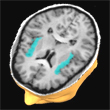Monday, 12 May 2014
We May Be Able To Have Feelings Without an Insula

The insula is a brain structure that lies deep inside the cerebral cortex and so is less accessible for examination. That is why so little was known about the insula for so long, until neurobiologists such as Antonio Damasio demonstrated its role in many human feelings. Because the insula receives so many signals from the strong internal bodily reactions associated with even our slightest emotions, it was seen as perfectly positioned to make us aware of these reactions.
That is what Damasio says in a February 2013 article in the journal Nature Reviews Neuroscience, in which he goes on to say that the role of the insula in generating our feelings may be more limited than some might believe. He points out several observations that are not highly consistent with the strong thesis that the insula is the essential platform for human emotions, and, by extension, for human consciousness, which develops from them. (more…)
Emotions and the Brain | Comments Closed
Tuesday, 29 April 2014
A “cyborg” which hears more than what we see
 Since 2004, Neil Harbisson has regarded himself as the first “cyborg” to be recognized as such by the government of a country—in his case, the United Kingdom, which has given him permission to appear in his passport photo with the small portable camera that he always wears on his forehead. This camera enables him not only to see colours, but also to hear them!
Since 2004, Neil Harbisson has regarded himself as the first “cyborg” to be recognized as such by the government of a country—in his case, the United Kingdom, which has given him permission to appear in his passport photo with the small portable camera that he always wears on his forehead. This camera enables him not only to see colours, but also to hear them!
Harbisson was born in 1982 with a rare congenital vision disorder called achromatopsia—the inability to see colours. This disorder can also arise following a brain injury, as neurologist Oliver Sacks reported in his writings. But Harbisson has seen the world only in black and white ever since he was born. (more…)
The Senses, Uncategorized | Comments Closed
Tuesday, 15 April 2014
The Collective Intelligence of Human Groups
 In psychology, the concept of general intelligence in individuals and the use of IQ tests to measure it are controversial topics, to say the least. One frequently cited piece of evidence for the existence of such intelligence is that this single variable predicts from one-third to one-half of individuals’ scores on a variety of distinct cognitive tasks.
In psychology, the concept of general intelligence in individuals and the use of IQ tests to measure it are controversial topics, to say the least. One frequently cited piece of evidence for the existence of such intelligence is that this single variable predicts from one-third to one-half of individuals’ scores on a variety of distinct cognitive tasks.
In a study published in the journal Science in October 2010, psychologists from three U.S. universities reported that they had discovered a factor that they called collective intelligence and that is similar to general intelligence but occurs in groups rather than in individuals. To test for this factor, the researchers formed dozens of groups of 2 to 5 people each and had them work for several hours on various tasks, ranging from creative brainstorming about a moral dilemma to playing checkers against a computer. (more…)
From Thought to Language | Comments Closed
Monday, 31 March 2014
Will You Be the Same Person in 10 Years As You are Now?
 Our thought processes are far from being as reliable and logical as we often think they are. In reality, our brains are constantly playing tricks on us, ranging from simple optical illusions to change blindness and other cognitive biases to the illusion that the self is a continuous entity that has the experiences that make up our lives.
Our thought processes are far from being as reliable and logical as we often think they are. In reality, our brains are constantly playing tricks on us, ranging from simple optical illusions to change blindness and other cognitive biases to the illusion that the self is a continuous entity that has the experiences that make up our lives.
Scientists are discovering more and more ways in which the brain fails to operate according to the simple common sense that we would expect. One notable example is the way that we perceive ourselves over time. In this regard, a study published in the January 2013 issue of the journal Science revealed a truly strange phenomenon that the authors call the “end of history illusion”—a reference to a concept originated by the German philosopher Hegel and advanced by American thinker Francis Fukuyama in a controversial 1992 book arguing that humanity had reached the end point in its sociocultural evolution. (more…)
Memory and the Brain | Comments Closed
Monday, 17 March 2014
Science Starting To Identify the Molecular Bases of the Sense of Touch
 When it comes to senses such as vision, scientists have known for some time which molecules are responsible for transduction—the conversion of physical stimuli into nerve impulses. Until recently, however, the molecular bases of the sene of touch remained ill-defined. But in an article first published online in the journal Nature in December 2012, Dr. Zhiqiang Yan and his research team from the University of California at San Francisco (UCSF) reported having found what they believed was the missing link in transduction for the sense of touch. (more…)
When it comes to senses such as vision, scientists have known for some time which molecules are responsible for transduction—the conversion of physical stimuli into nerve impulses. Until recently, however, the molecular bases of the sene of touch remained ill-defined. But in an article first published online in the journal Nature in December 2012, Dr. Zhiqiang Yan and his research team from the University of California at San Francisco (UCSF) reported having found what they believed was the missing link in transduction for the sense of touch. (more…)
The Senses | Comments Closed








